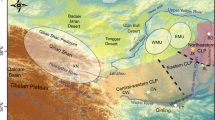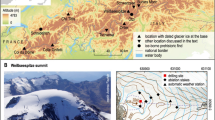Abstract
The initial desertification in the Asian interior is thought to be one of the most prominent climate changes in the Northern Hemisphere during the Cenozoic era1,2,3,4. But the dating of this transition is uncertain, partly because desert sediments are usually scattered, discontinuous and difficult to date. Here we report nearly continuous aeolian deposits covering the interval from 22 to 6.2 million years ago, on the basis of palaeomagnetic measurements and fossil evidence. A total of 231 visually definable aeolian layers occur as brownish loesses interbedded with reddish soils. This new evidence indicates that large source areas of aeolian dust and energetic winter monsoon winds to transport the material must have existed in the interior of Asia by the early Miocene epoch, at least 14 million years earlier than previously thought3,5. Regional tectonic changes and ongoing global cooling are probable causes of these changes in aridity and circulation in Asia.
This is a preview of subscription content, access via your institution
Access options
Subscribe to this journal
Receive 51 print issues and online access
$199.00 per year
only $3.90 per issue
Buy this article
- Purchase on SpringerLink
- Instant access to full article PDF
Prices may be subject to local taxes which are calculated during checkout



Similar content being viewed by others
References
Ruddiman, W. F. & Kutzbach, J. E. Forcing of late Cenozoic northern hemisphere climate by plateau uplift in southern Asia and the American West. J. Geophys. Res. 94, 18409–18427 (1989).
Manabe, S. & Broccoli, A. J. Mountains and arid climates of middle latitudes. Science 247, 192–195 (1990).
An, Z. S., Kutzbach, J. E., Prell, W. L. & Porter, S. C. Evolution of Asian monsoons and phased uplift of the Himalaya–Tibetan plateau since Late Miocene times. Nature 411, 62–66 (2001).
Ramstein, G., Fluteau, F., Besse, J. & Joussaume, S. Effect of orogeny, plate motion and land-sea distribution on Eurasian climate change over the past 30 million years. Nature 386, 788–795 (1997).
Guo, Z. T., Peng, S. Z., Hao, Q. Z., Biscay, P. E. & Liu, T. S. Origin of the Miocene-Pliocene Red-Earth formation at Xifeng in northern China and implications for paleoenvironments. Palaeogeogr. Palaeoclimatol. Palaeoecol. 170, 11–26 (2001).
Whalley, W. B., Marshall, J. R. & Smith, B. J. Origin of desert loess from some experimental observations. Nature 300, 433–435 (1982).
Liu, T. S. Loess and the Environment (China Ocean, Beijing, 1985).
Kukla, G., An, Z. S., Melice, J. L., Gavin, J. & Xiao, J. L. Magnetic susceptibility record of Chinese loess. Trans. R. Soc. Edinb. Earth Sci. 81, 263–288 (1990).
Sun, D. H., An, Z. S., Shaw, J., Bloemendal, J. & Sun, Y. B. Magnetostratigraphy and paleoclimatic significance of Late Tertiary aeolian sequences in the Chinese Loess Plateau. Geophys. J. Int. 134, 207–212 (1998).
Sun, D. H., Shaw, J., An, Z. S., Chen, M. Y. & Yue, L. P. Magnetostratigraphy and paleoclimatic interpretation of a continuous 7.2 Ma late Cenozoic eolian sediments from the Chinese Loess Plateau. Geophys. Res. Lett. 25, 85–88 (1998).
Ding, Z. L. et al. Wind-blown origin of the Pliocene red clay formation in the central Loess Plateau, China. Earth Planet. Sci. Lett. 161, 135–143 (1998).
Duchaufour, Ph. Pédologie Tome 1 Pédogenèse et Classification (Masson, Paris/New York/Barcelone/Milan, 1983).
Maher, B. A. Characterization of soils by mineral magnetic measurements. Phys. Earth Planet. Inter. 42, 76–92 (1986).
Guo, Z. T. et al. Climate extremes in loess of China coupled with the strength of deep-water formation in the North Atlantic. Glob. Planet. Change 18, 113–128 (1998).
Pye, K. & Sperling, C. H. B. Experimental investigation of silt formation by static breakage processes: the effect of temperature, moisture and salt on quartz dune sand and granitic regolith. Sedimentology 30, 49–62 (1983).
Zheng, S. H. in Rodent and Lagomorph Families of Asian Origins and Diversification (eds Tomida, Y., Li, C. K. & Setoguchi, T.) 57–76 (National Science Museum Monographs 8, Tokyo, 1994).
Mein, P. in European Neogene Mammal Chronology (eds Lindsay, E. H., Fahlbusch, V. & Mein, P.) 73–90 (NATO ASI Series A 180, Plenum, New York, 1990).
Qiu, Z. D. Middle Miocene Micromammalian Fauna from Tunggur, Nei Mongol (Science, Beijing, 1996).
Qiu, Z. X., Xu, W. Y. & Qiu, Z. D. in The Miocene Land Mammals of Europe (eds Rössner, G. & Heissig, K.) 443–455 (Pfeil, München, 1999).
Bruijn, H., Hussain, S. T. & Leinders, J. J. M. Fossil rodents from the Murree formation near Banda Daud Shah, Kohat, Pakistan. Proc. Koninklijke Nederlandse Akad. Wetenschappen Ser. B 84, 71–99 (1981).
Cande, S. C. & Kent, D. V. Revised calibration of the geomagnetic polarity timescale for the late Cretaceous and Cenozoic. J. Geophys. Res. 100, 6093–6095 (1995).
Berger, A., Loutre, M. F. & Laskar, J. Stability of the astronomical frequencies over the Earth's history for paleoclimate studies. Science 255, 560–566 (1992).
Zhang, X. Y., Arimoto, R. & An, Z. S. Dust emission from Chinese desert sources linked to variations in atmospheric circulation. J. Geophys. Res. 102, 28041–28047 (1997).
Wang, H. Z. (ed.) Atlas of the Paleogeography of China 121–123 (Cartographic, Beijing, 1985).
Chung, S. L. et al. Diachronous uplift of the Tibetan plateau starting 40 Myr ago. Nature 394, 769–773 (1998).
Harrison, T. M., Copeland, P., Kidd, W. S. F. & Yin, A. Raising Tibet. Science 255, 1663–1670 (1992).
Jansen, E. & Sjoholm, J. Reconstruction of glaciation over the past 6 Myr from ice-borne deposits in the Norwegian Sea. Nature 349, 600–603 (1991).
Wolfe, J. A. in The Carbon Cycle and Atmospheric CO2: Natural Variations Archaean to Present (eds Sundquist, E. T. & Broecker, W. S.) 357–375 (Monograph 32, American Geophysical Union, Washington DC, 1985).
Miller, K. G., Fairbanks, R. G. & Mountain, G. S. Tertiary oxygen isotope synthesis, sea level history, and continental margin erosion. Paleoceanography 2, 1–19 (1987).
Rea, D. K., Snoeckx, H. & Joseph, L. H. Late Cenozoic eolian deposition in the North Pacific: Asian drying, Tibetan uplift, and cooling of the northern hemisphere. Paleoceanography 13, 215–224 (1998).
Acknowledgements
We thank W. Wu, Z. Qiu, S. Zheng and Z. Qiu for the identification of micromammalian fossils, and Z.S. An, J. Guiot and R. Potts for discussions. This work is supported by the National Natural Science Foundation of China, the National Project for Basic Research on Tibetan Plateau, Chuangxin and Bairen Programs of the Chinese Academy of Sciences.
Author information
Authors and Affiliations
Corresponding author
Supplementary information
Rights and permissions
About this article
Cite this article
Guo, Z., Ruddiman, W., Hao, Q. et al. Onset of Asian desertification by 22 Myr ago inferred from loess deposits in China. Nature 416, 159–163 (2002). https://doi.org/10.1038/416159a
Received:
Accepted:
Issue Date:
DOI: https://doi.org/10.1038/416159a
This article is cited by
-
Ensemble species distribution modeling and multilocus phylogeography provide insight into the spatial genetic patterns and distribution dynamics of a keystone forest species, Quercus glauca
BMC Plant Biology (2024)
-
Unraveling weak and short South Asian wet season in the Early Eocene warmth
Communications Earth & Environment (2024)
-
Late Cenozoic uplift of the Liupan Mountains: Evidence from the Neogene loess deposits
Science China Earth Sciences (2024)
-
Paleoclimatic application of spectral parameters to the eolian red clay of the Jianzha Basin, northeastern margin of the Tibetan Plateau
Science China Earth Sciences (2024)
-
A comprehensive dataset of luminescence chronologies and environmental proxy indices of loess-paleosol deposits across Asia
npj Climate and Atmospheric Science (2024)




